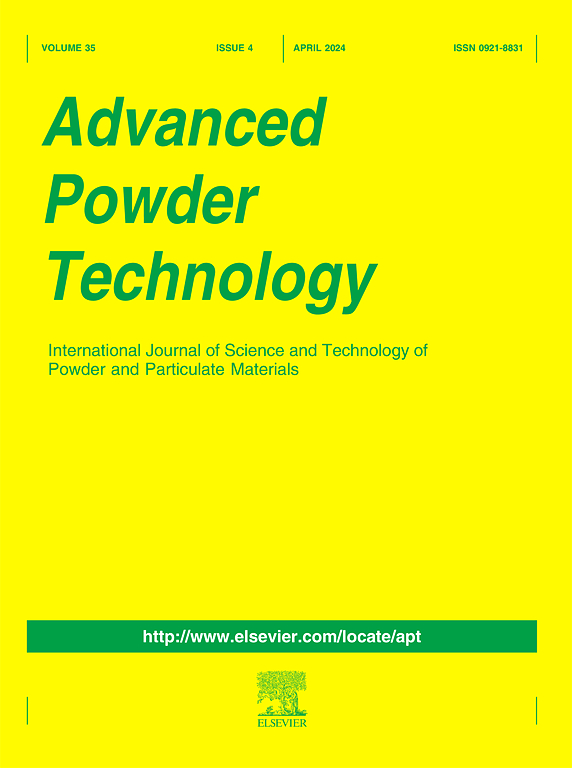An effective strategy for synthesizing spinel NixMn1-xFe2O4 by oxidation roasting technology: Synergetic reaction and phase evolution behavior
IF 4.2
2区 工程技术
Q2 ENGINEERING, CHEMICAL
引用次数: 0
Abstract
An oxidation roasting technology has been reported as an effective technology for successfully synthesizing nickel manganese ferrite NixMn1-xFe2O4 (0 < x < 1) with a spinel crystal structure. The experimental results demonstrated the successful synthesis of nickel manganese ferrite Ni0.5Mn0.5Fe2O4 samples with relatively high purities at an oxidation roasting temperature of 1200 °C for 2 h with a Ni:Mn:Fe molar ratio of 1:1:4. The synthesized samples exhibited a magnetization saturation (Ms) value of 53.71 emu/g, a coercivity (Hc) value of 34.88 Oe, and a remanent magnetization (Mr) of 3.64 emu/g. Additionally, these samples had a total pore volume of 0.071 cm3/g, a Specific Surface Area (SSA) of 24.13 cm2/g, and an Average Particle Size (APS) of 12.32 nm. It was concluded that the synthesis route of NixMn1-xFe2O4 could be theoretically summarized into two routes. One route involves the simultaneous substitution of divalent iron (Fe2+) and trivalent iron (Fe3+) in the spinel structure of (Fe)[Fe]2O4 by divalent manganese ions (Mn2+) and trivalent nickel ions (Ni3+), resulting in the formation of (Mn)x(Fe)1-x[Ni]y[Fe]2-yO4 with a spinel crystal structure. In this structure, the Ni3+ ions preferentially occupy the octahedral sites, whereas the Mn2+ ions predominantly reside in the tetrahedral sites of the nickel manganese ferrites (Mn)x(Fe)1-x[Ni]y[Fe]2-yO4. Furthermore, the mixed spinel crystal structure of (Ni)y(Fe)1-y[Mn]x[Fe]2-xO4 could be transformed into nickel manganese ferrite (Mn)x(Fe)1-x[Ni]y[Fe]2-yO4 under the influence of a higher oxidization roasting temperature. Nickel manganese ferrite NixMn1-xFe2O4 (0 < x < 1) with normal and inverse spinel structures inevitably coexists and co-transformed in the synthesis process of NixMn1-xFe2O4 by oxidation roasting technology.

氧化焙烧技术合成尖晶石NixMn1-xFe2O4的有效策略:协同反应和相演化行为
氧化焙烧技术是成功合成镍锰铁氧体NixMn1-xFe2O4 (0 <;x & lt;1)具有尖晶石晶体结构。实验结果表明,在1200℃的氧化焙烧温度下,Ni:Mn:Fe摩尔比为1:1:4,焙烧2 h,成功合成了纯度较高的镍锰铁氧体Ni0.5Mn0.5Fe2O4样品。所得样品的磁化饱和度(Ms)为53.71 emu/g,矫顽力(Hc)为34.88 Oe,剩余磁化强度(Mr)为3.64 emu/g。此外,这些样品的总孔隙体积为0.071 cm3/g,比表面积(SSA)为24.13 cm2/g,平均粒径(APS)为12.32 nm。结果表明,理论上可以将NixMn1-xFe2O4的合成路线归纳为两条路线。一种途径是在(Fe)[Fe]2O4的尖晶石结构中,二价铁(Fe2+)和三价铁(Fe3+)同时被二价锰离子(Mn2+)和三价镍离子(Ni3+)取代,形成具有尖晶石晶体结构的(Mn)x(Fe)1-x[Ni]y[Fe]2-yO4。在该结构中,Ni3+离子优先占据八面体位置,而Mn2+离子主要位于镍锰铁氧体(Mn)x(Fe)1-x[Ni]y[Fe]2-yO4的四面体位置。此外,在较高的氧化焙烧温度的影响下,(Ni)y(Fe)1-y[Mn]x[Fe]2-xO4的混合尖晶石晶体结构可以转变为镍锰铁氧体(Mn)x(Fe)1-x[Ni]y[Fe]2-yO4。镍锰铁氧体NixMn1-xFe2O4 (0 <;x & lt;1)氧化焙烧法合成NixMn1-xFe2O4过程中,正反尖晶石结构不可避免地共存共转化。
本文章由计算机程序翻译,如有差异,请以英文原文为准。
求助全文
约1分钟内获得全文
求助全文
来源期刊

Advanced Powder Technology
工程技术-工程:化工
CiteScore
9.50
自引率
7.70%
发文量
424
审稿时长
55 days
期刊介绍:
The aim of Advanced Powder Technology is to meet the demand for an international journal that integrates all aspects of science and technology research on powder and particulate materials. The journal fulfills this purpose by publishing original research papers, rapid communications, reviews, and translated articles by prominent researchers worldwide.
The editorial work of Advanced Powder Technology, which was founded as the International Journal of the Society of Powder Technology, Japan, is now shared by distinguished board members, who operate in a unique framework designed to respond to the increasing global demand for articles on not only powder and particles, but also on various materials produced from them.
Advanced Powder Technology covers various areas, but a discussion of powder and particles is required in articles. Topics include: Production of powder and particulate materials in gases and liquids(nanoparticles, fine ceramics, pharmaceuticals, novel functional materials, etc.); Aerosol and colloidal processing; Powder and particle characterization; Dynamics and phenomena; Calculation and simulation (CFD, DEM, Monte Carlo method, population balance, etc.); Measurement and control of powder processes; Particle modification; Comminution; Powder handling and operations (storage, transport, granulation, separation, fluidization, etc.)
 求助内容:
求助内容: 应助结果提醒方式:
应助结果提醒方式:


